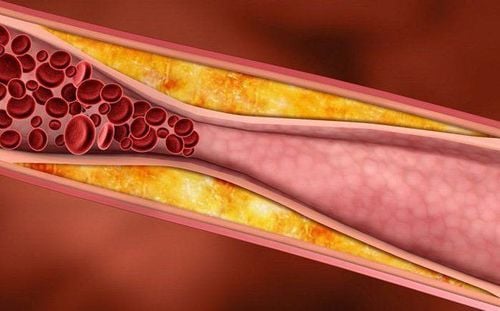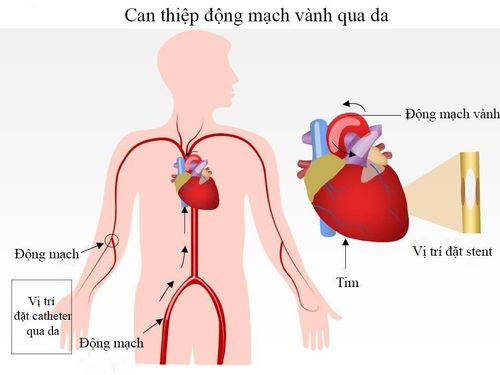This is an automatically translated article.
The article is professionally consulted by Master, Doctor Tran Hong Nhat - Interventional Cardiologist - Cardiovascular Center - Vinmec Central Park International General Hospital.Coronary intervention is a procedure that helps to solve the narrowing and blockage of coronary arteries without the need for open thoracic surgery. Over the years, this method has achieved many advances both in terms of technique and effectiveness in treatment.
1. What is coronary intervention?
Coronary heart disease (or ischemic heart disease) is one of the leading causes of death in Vietnam as well as in the world, as a result of the imbalance between myocardial oxygen supply and demand due to perfusion. inadequate, causing myocardial ischemia or myocardial necrosis.Treatment of coronary heart disease includes the following methods:
Medical treatment and lifestyle changes Revascularization of narrowed coronary arteries with stenting Coronary artery bypass surgery. Percutaneous coronary intervention is a procedure in which a small catheter is inserted from the radial or femoral artery into the coronary artery to open the narrowed or blocked coronary artery with an instrument such as a balloon or a stent. (stent)
Unlike coronary artery bypass surgery, which requires opening the chest, coronary intervention is a minimally invasive procedure that is performed through a small incision in the skin (usually the wrist or groin). ). Patients only need local anesthesia, no anesthesia is needed, so they are fully awake and feel no pain during the procedure.
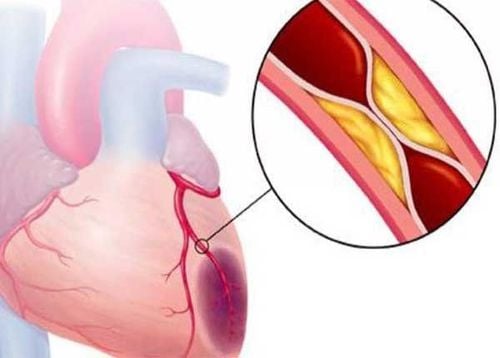
Bệnh lý mạch vành cần được can thiệp
2. Indications for coronary intervention
Stable angina that is not controlled despite optimal medical therapy. Stable angina, evidence of myocardial ischemia (positive stress test or positive myocardial perfusion scan) and coronary artery disease supplying large areas of myocardium. Unstable chest pain/acute myocardial infarction without ST elevation with high risk stratification. Acute myocardial infarction with ST elevation. Angina occurs after coronary artery bypass surgery. There are symptoms of coronary re-stenosis after percutaneous coronary intervention3. How to perform angioplasty
Before an angioplasty procedure, you will be explained why this technique is needed, how it is performed, and possible complications during and after the procedure. When you agree to the procedure, you will sign an undertaking to perform the procedure.You are required to take adequate antiplatelet drugs (aspirin, clopidogrel) before the interventional procedure. You are examined and assessed for comorbid conditions (gastric disease, chronic lung disease), kidney function..., medical history such as history of gastrointestinal bleeding, coagulation disorders, etc. allergy to contrast agents ... Percutaneous coronary angiography and intervention can be performed through the carpal or inguinal arteries. The procedure area will be cleaned and shaved, disinfected and local anesthetic applied. The doctor then inserts a needle to make a small hole in the artery in that area.
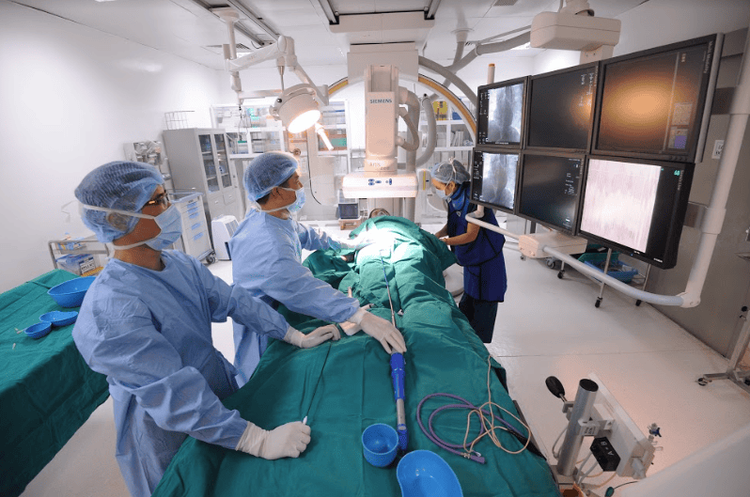
Bác sĩ tiến hành can thiệp động mạch vành tại Vinmec
A small catheter is inserted through the fatty area of the blood vessel into the heart. After the catheter has been inserted into the coronary artery, the contrast solution will be pumped through the catheter system into the coronary artery. As a result, the image of the coronary artery system is displayed on the bright screen, based on these images, it is possible to evaluate the lesions of the coronary artery system such as stenosis, occlusion, dissection, thrombosis, ...
Angioplasty:
If there is a narrowing of the coronary artery that requires dilation, the doctor will thread a very small flexible wire through the catheter to the coronary artery. The balloon will be threaded through the catheter to the narrow site and inflated. After the coronary lumen has expanded, the balloon is deflated and withdrawn.
To prevent the coronary artery from narrowing again after balloon angioplasty, a stent is inserted into the stenosis. The stent is inflated by balloon inflation, resulting in the stent pressing against the vessel lumen and widening the lumen. The balloon is then deflated, detached from the stent and sucked out, leaving the stent in place.
After dilation and stenting, the lumen of the blood vessel at the stenosis site is widened, allowing more blood to pass through the stenosis, helping to reduce symptoms of chest pain, as well as improve the prognosis.
4. Possible risks in coronary intervention
Coronary angiography and interventional procedures are invasive, so certain risks may still occur. The risks of this procedure include bleeding, infection, allergic reaction to the contrast dye, risk of blood vessel damage, stroke, and kidney failure.In addition, there are cases where the placed stents can become blocked or narrow, causing myocardial ischemia and requiring re-intervention. But with the advancement of medicine in terms of both equipment and technology, we should not be too worried about these risks, because according to the statistics of large studies around the world, complications need intervention. Emergency or death related to this technique is quite low (less than 1%).
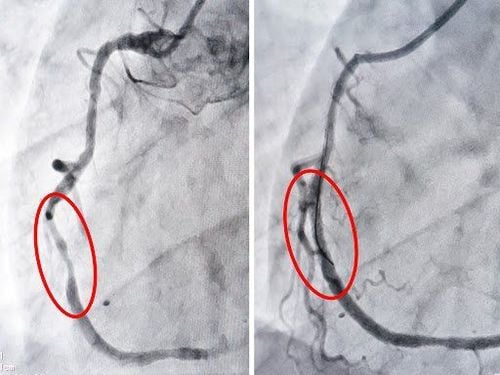
Hình ảnh đặt stent mạch vành hiển thị trên màn hình
Master, Doctor Tran Hong Nhat has more than 10 years of experience in examining and treating interventional cardiovascular diseases. The doctor has participated in training courses at home and abroad. The doctor used to be an interventional cardiologist at Hue Central Hospital before working at the Cardiovascular Center - Vinmec Central Park Hospital as it is now.
Customers can directly go to Vinmec Health system nationwide to visit or contact the hotline here for support.






